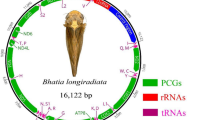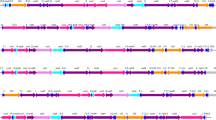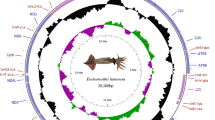Abstract
The phylogenetic position of Xenoturbella bocki has been a matter of controversy since its description in 1949. We sequenced a second complete mitochondrial genome of this species and performed phylogenetic analyses based on the amino acid sequences of all 13 mitochondrial protein-coding genes and on its gene order. Our results confirm the deuterostome relationship of Xenoturbella. However, in contrast to a recently published study (Bourlat et al. in Nature 444:85–88, 2006), our data analysis suggests a more basal branching of Xenoturbella within the deuterostomes, rather than a sister-group relationship to the Ambulacraria (Hemichordata and Echinodermata).





Similar content being viewed by others
References
Abascal F, Zardoya R, Posada D (2005) ProtTest : selection of best-fit models of protein evolution. Bioinformatics 21:2104–2105
Abascal F, Zardoya R, Posada D (2006) GenDecoder : genetic code prediction for metazoan mitochondria. Nucleic Acids Res 34:389–393
Adachi J, Hasegawa M (1996) Model of amino acid substitution in proteins encoded by mitochondrial DNA. J Mol Evol 42:459–468
Altschul SF, Madden TL, Schaffer AA, Zhang J, Zhang Z, Miller W, Lipman DJ, (1997) Gapped BLAST and PSI-BLAST : a new generation of protein database search programs. Nucleic Acids Res 25:3389–3402
Boore JL (1999) Animal mitochondrial genomes. Nucleic Acids Res 27:1767–1780
Bourlat SJ, Nielsen C, Lockyer AE, Littlewood DT, Telford MJ (2003) Xenoturbella is a deuterostome that eats molluscs. Nature 424:925–928
Bourlat SJ, Juliusdottir T, Lowe CJ, Freeman R, Aronowicz J, Kirschner M, Lander ES, Thorndyke M, Nakano H, Kohn AB, Heyland A, Moroz LL, Copley RR, Telford MJ (2006) Deuterostome phylogeny reveals monophyletic chordates and the new phylum xenoturbellida. Nature 444:85–88
Castresana J, Feldmaier-Fuchs G, Pä äbo S (1998a). Codon reassignment and amino acid composition in hemichordate mitochondria. Proc Natl Acad Sci USA 95:3703–3707
Castresana J, Feldmaier-Fuchs G, Yokobori S, Satoh N, Pääbo S, (1998b). The mitochondrial genome of the hemichordata Balanoglossus carnosus and the evolution of deuterostome mitochondria. Genetics 150:1115–1123
Ehlers U (1991) Comparative morphology of statocysts in the Platyhelminthes and the Xenoturbellida. Hydrobiologia 227:263–271
Ehlers U, Sopott-Ehlers B (1997a) Xenoturbella bocki: organisation and phylogenetic position as sister taxon of the bilateria. Verh Dtsch Zool Ges 90:168
Ehlers U, Sopott-Ehlers B (1997b) Ultrastructure of the subepidermal musculature of Xenoturbella bocki, the adelphotaxon of the bilateria. Zoomorphology 117:71–79
Fitch DH (2005) (ed) Introduction to nematode evolution and ecology. In: The C. elegans research community. WormBook. doi: /10.1895/wormbook.1.19.1 (31 August, 2005)
Franzén Å, Afzelius BA (1987) The ciliated epidermis of Xenoturbella bocki (Platyhelminthes, Xenoturbellida) with some phylogenetic considerations. Zool Scr 16:9–17
Fritzsch G, Schlegel M, Stadler P (2006) Alignments of mitochondrial genome arrangements: applications to metazoan phylogeny. J Theor Biol 240:511–520
Himeno H, Masaki H, Kawai T, Ohta T, Kumagai I, Miura K, Watanabe K (1987) Unusual genetic codes and a novel gene structure for tRNA(AGYSer) in starfish mitochondrial DNA. Gene 56:219–230
Hofacker IL, Fontana W, Stadler PF, Bonhoeffer LS, Tacker M, Schuster P (1994) Fast folding and comparison of RNA secondary structures. Monatsh Chem 125:167–188
Israelsson O (1997) ... and molluscan embryogenesis. Nature 390:32
Israelsson O (1999) New light on the enigmatic Xenoturbella (phylum uncertain): ontogeny and phylogeny. Proc R Soc Lond Ser B 266:835–841
Israelsson O, Budd GE (2005) Eggs and embryos in Xenoturbella (phylum uncertain) are not ingested prey. Dev Genes Evol 215:358–363
Jägersten G (1959) Further remarks on the early phylogeny of metazoa. Zoologiska Bidrag 33:79–108
Lartillot N, Philippe H (2004) A Bayesian mixture model for across-site heterogeneities in the amino-acid replacement process. Mol Biol Evol 21:1095–1109
Lartillot N, Philippe H (2006) Computing Bayes factors using thermodynamic integration. Syst Biol 55:195–207
Lavrov DV, Brown WM (2001) Trichinella spiralis mtDNA: a nematode mitochondrial genome that encodes a putative ATP8 and normally structured tRNAs and has a gene arrangement relatable to those of coelomate metazoans. Genetics 157:621–637
Lavrov DV, Lang BF (2005) Poriferan mtDNA and animal phylogeny based on mitochondrial gene arrangements. Syst Biol 54:651–659
Lowe TM, Eddy SR (1997) tRNAscan-SE : a program for improved detection of transfer RNA genes in genomic sequence. Nucleic Acids Res 25:955–964
Lundin K (1998) The epidermal ciliary rootlets of Xenoturbella bocki (Xenoturbellida) revisited: new support for a possible kinship with the acoelomorpha (Platyhelminthes). Zool Scr 27:263–270
Nohara M, Nishida M, Miya M, Nishikawa T (2005) Evolution of the mitochondrial genome in cephalochordata as inferred from complete nucleotide sequences from two Epigonichthys species. J Mol Biol 60:526–537
Noren M, Jondelius U (1997) Xenoturbella’s molluscan relatives. Nature 390:31–32
Notredame C, Higgins D, Heringa J (2000) T-Coffee : a novel method for multiple sequence alignments. J Mol Biol 302:205–217
Pedersen KJ, Pedersen LR (1986) Fine structural observations on the extracellular matrix (ECM) of Xenoturbella bocki Westblad, 1949. Acta Zool 67:103–113
Pedersen KJ, Pedersen LR (1988) Ultrastructural observations on the epidermis of Xenoturbella bocki Westblad, 1949; with a discussion of epidermal cytoplasmic filament systems of invertebrates. Acta Zool 69:231–246
Raikova OI, Reuter M, Jondelius U, Gustafsson MKS (2000) An immunocytochemical and ultrastructural study of the nervous and muscular systems of Xenoturbella westbladi (bilateria inc. sed.). Zoomorphology 120:107–118
Reisinger E (1960) Was ist Xenoturbella? Z Wiss Zool 164:188–198
Rieger RM, Tyler S, Smith III JPS, Rieger G (1991) Platyhelminthes: Turbellaria. In: Harrison FW, Bogitsh BJ (eds) Microscopic anatomy of invertebrates. Volume 3: Platyhelminthes and Nemertinea. Wiley-Liss, New York, pp 7–140
Rohde K, Watson N, Cannon LRG (1988) Ultrastructure of epidermal cilia of Pseudactinoposthia sp. (Platyhelminthes, Acoela): implications for the phylogenetic status of the Xenoturbellida and Acoelomorpha. J Submicrosc Cytol Pathol 20:759–767
Ronquist F, Huelsenbeck JP (2003) MrBayes 3 : Bayesian phylogenetic inference under mixed models. Bioinformatics 19:1572–1574
Ruiz-Trillo I, Paps J, Loukota M, Ribera C, Jondelius U, Baguñà J, Riutort M (2002) A phylogenetic analysis of myosin heavy chain type II sequences corroborates that Acoela and Nemertodermatida are basal bilaterians. Proc Natl Acad Sci USA 99:11246–11251
Ruiz-Trillo I, Riutort M, Fourcade HM, Bagunñà J, Boore JL (2004) Mitochondrial genome data support the basal position of Acoelomorpha and the polyphyly of the Platyhelminthes. Mol Phylogenet Evol 33:321–332
Sankoff D, Leduc G, Antoine N, Paquin B, Lang BF (1992) Gene order comparisons for phylogenetic inference: evolution of the mitochondrial genome. Proc Natl Acad Sci USA 89:6575–6579
Schmidt HA, Strimmer K, Vingron M, von Haeseler A (2002) TREEPUZZLE : maximum likelihood phylogenetic analysis using quartets and parallel computing. Bioinformatics 18:502–504
Stach T, Dupont S, Isrealson O, Fauville G, Nakano H, Kånneby T, horndyke M (2005) Nerve cells of Xenoturbella bocki (phylum uncertain) and Harrimania kupfferi (enteropneusta) are positively immunoreactive to antibodies raised against echinoderm neuropeptides. J Mar Biol Assoc UK 85:1519–1524
Swofford DL (2002) PAUP* : Phylogenetic Analysis Using Parsimony (*and Other Methods) Version 4.0b10. Sinauer Associates, Sunderland (Handbook and Software)
Telford MJ, Lockyer AE, Cartwright-Finch C, Littlewood DT (2003) Combined large and small subunit ribosomal RNA phylogenies support a basal position of the acoelomorph flatworms. Proc Biol Sci 270:1077–1083
Westblad E (1949) Xenoturbella bocki n.g., n.sp., a peculiar, primitive Turbellarian type. Ark Zool 1:3–29
Yokobori SI, Watanabe Y, Oshima T (2003) Mitochondrial genome of Ciona savignyi (Urochordata, Ascidiacea, Enterogona): comparison of gene arrangement and tRNA genes with Halocynthia roretzi mitochondrial genome. J Mol Evol 57:574–587
Yokobori S, Oshima T, Wada H (2005) Complete nucleotide sequence of the mitochondrial genome of Doliolum nationalis with implications for evolution of Urochordates. Mol Phylogenet Evol 34:273–283
Zrzavy J, Mihulka S, Kepka P, Bezdek A, Tietz D (1998) Phylogeny of the metazoa based on morphological and 18S ribosomal DNA evidence. Cladistics 14:249–285
Acknowledgment
The project was funded by the Deutsche Forschungsgemeinschaft under the auspices of SPP-1174 Deep Metazoan Phylogeny, Projects HA 2103/4-1, SCHL 229/14-1, STA 850/2-1, and STA 850/3-1.
Author information
Authors and Affiliations
Corresponding author
Rights and permissions
About this article
Cite this article
Perseke, M., Hankeln, T., Weich, B. et al. The mitochondrial DNA of Xenoturbella bocki: genomic architecture and phylogenetic analysis. Theory Biosci. 126, 35–42 (2007). https://doi.org/10.1007/s12064-007-0007-7
Received:
Accepted:
Published:
Issue Date:
DOI: https://doi.org/10.1007/s12064-007-0007-7




